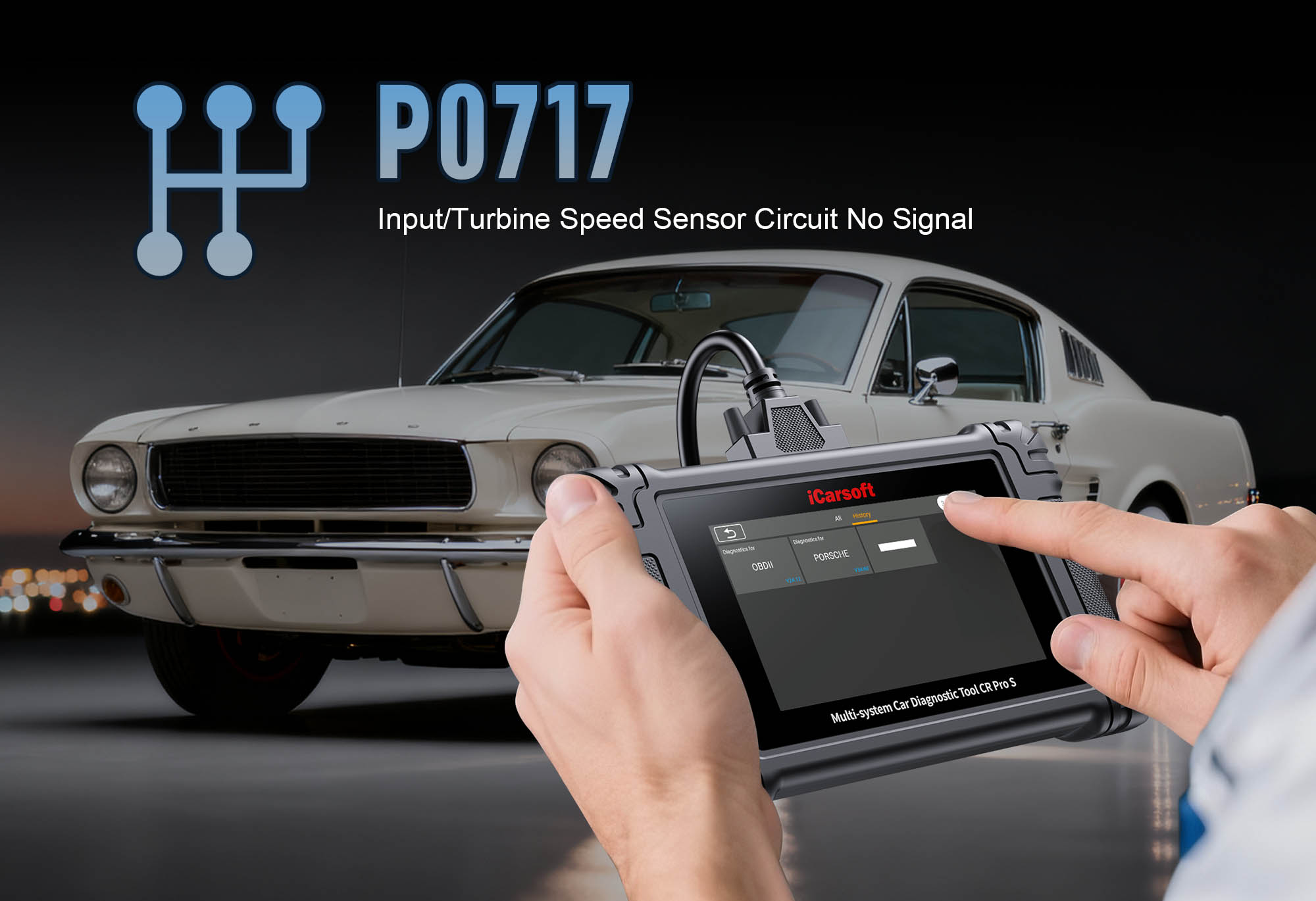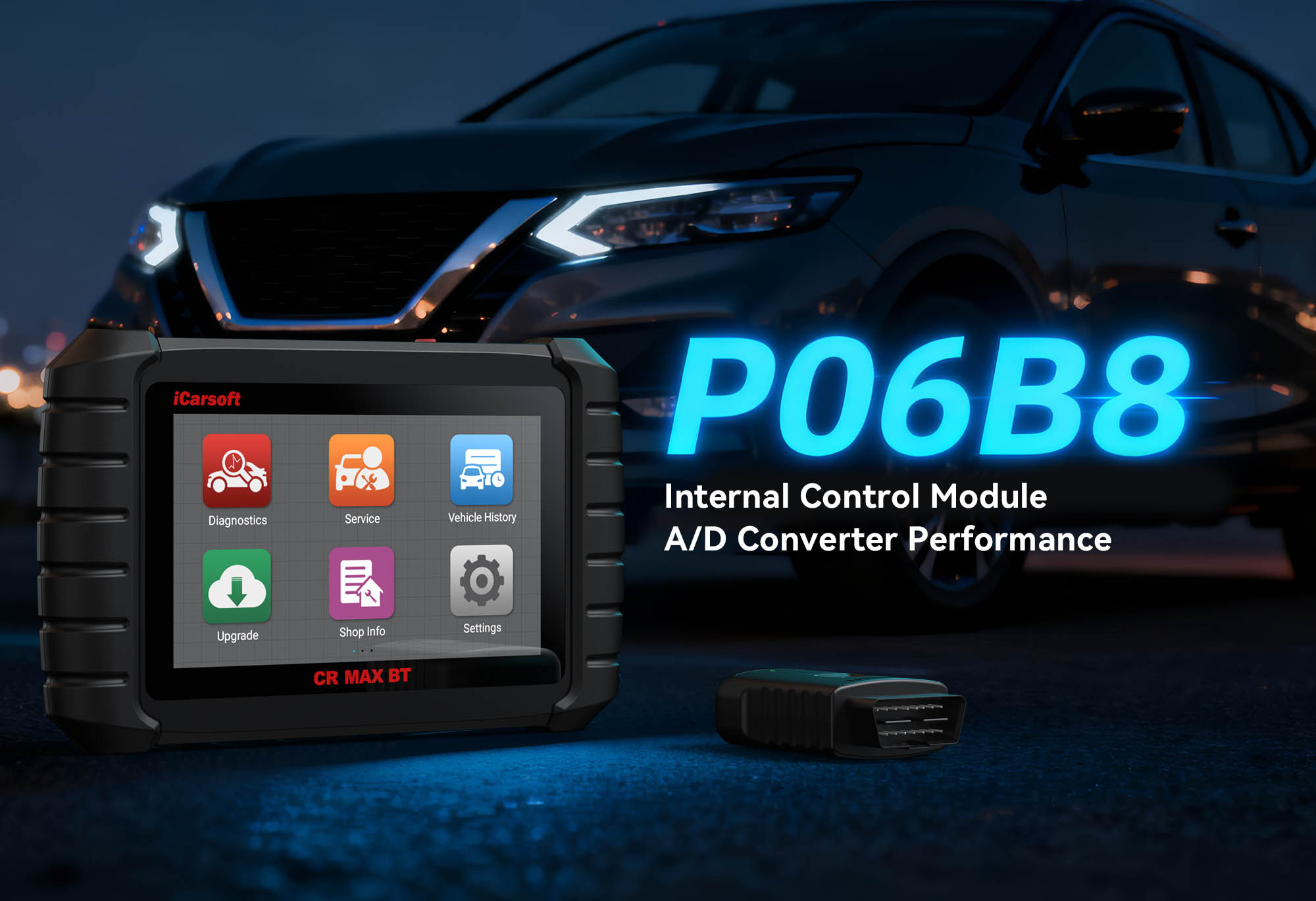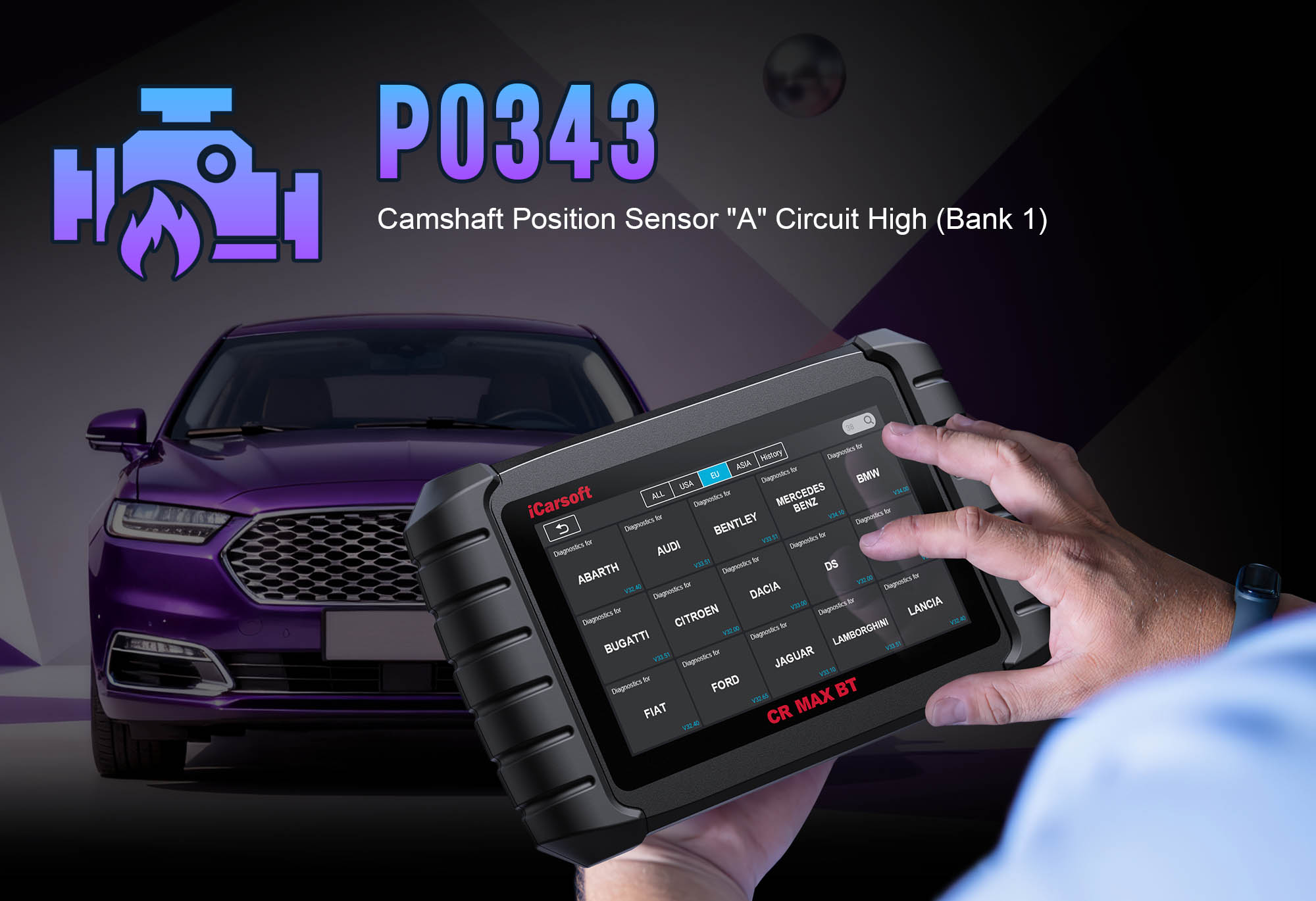Diagnose & Clear P0717 with iCarsoft CR Elite P: Fix Transmission Fluid Temperature Sensor Circuit No Signal
If your check engine light illuminates, your transmission slips during gear shifts, or you notice a "Transmission Overheating" warning, a diagnostic scan will likely return P0717. This OBD-II code stands for "Transmission Fluid Temperature (TFT) Sensor Circuit No Signal"—a critical fault indicating the Transmission Control Module (TCM) is not receiving any data from the TFT sensor. The TFT sensor monitors transmission fluid temperature (critical for adjusting shift timing, pressure, and fluid viscosity); without this signal, the TCM defaults to a "safe" mode, causing harsh shifts, reduced fuel efficiency, and even permanent transmission damage if ignored.
Basic scanners may only flag "TFT sensor fault" but can’t test sensor wiring, verify TCM communication, or check fluid temperature in real time—leaving you unable to confirm if the issue is a bad sensor, broken wire, or faulty TCM. The iCarsoft CR Elite P, with its specialized transmission system diagnostics, bi-directional testing, and global vehicle coverage, solves this. Let’s walk through how to diagnose and resolve P0717 with precision, leveraging the CR Elite P’s unique capabilities to protect your transmission.
Understanding P0717: Causes & Key Symptoms
A missing signal from the TFT sensor disrupts the TCM’s ability to optimize transmission performance, leading to symptoms that worsen over time (delays increase the risk of overheating):
Key Symptoms of P0717
-
Check Engine Light (CEL) + Transmission Warning Light: Both often illuminate together—the CEL for P0717, and a dedicated "Transmission Fault" light (in newer vehicles) for TCM safe mode.
-
Harsh or Delayed Gear Shifts: The TCM can’t adjust shift pressure based on fluid temperature, leading to jolts when shifting from "Park" to "Drive" or delayed upshifts/downshifts.
-
Transmission Slipping: Fluid that’s too hot (undetected by a faulty sensor) thins out, reducing friction—causing the transmission to slip (engine revs but speed doesn’t increase).
-
Reduced Power/Limp Mode: To prevent overheating, the TCM limits transmission output, capping speed at 30–40 mph and disabling sport modes.
-
Inaccurate Temperature Readings: The transmission temperature gauge (if equipped) shows "---" or stays at a fixed value (e.g., 60°F) instead of updating.
-
Increased Fluid Degradation: Unmonitored high temperatures break down transmission fluid, leading to sludge buildup and accelerated wear on clutches/bearings.
Common Causes of P0717
|
Cause
|
Description
|
|
Faulty TFT Sensor
|
Internal failure of the sensor (common in vehicles >100,000 miles—fluid contaminants or vibration damage the sensor’s thermistor).
|
|
Broken or Shorted Wiring
|
Frayed insulation, rodent damage, or corrosion in the sensor’s wiring harness cuts off the signal to the TCM.
|
|
Loose or Corroded Connector
|
The TFT sensor’s electrical connector (often mounted on the transmission case) becomes loose or corroded, disrupting signal flow.
|
|
Failed TCM
|
A faulty TCM can’t receive or process the sensor signal (rare, but possible in 2015+ vehicles with electronic TCMs).
|
|
Low or Contaminated Transmission Fluid
|
Low fluid levels prevent the sensor from contacting fluid; dirty fluid clogs the sensor’s probe, blocking temperature readings.
|
|
Sensor Dislodgement
|
The sensor (if mounted in the fluid pan) becomes loose or falls out, failing to measure temperature.
|
Why iCarsoft CR Elite P Excels at Diagnosing P0717
The CR Elite P outperforms basic tools with features tailored to transmission and TFT sensor diagnostics—critical for resolving P0717:
Live Transmission Fluid Temperature Tracking
Monitors real-time temperature data (in °F/°C) from the TCM (if available) or alternative sensors, confirming if the TFT sensor is sending no signal.
TFT Sensor Circuit Tests
Checks for open circuits, short circuits, or low voltage in the sensor’s wiring/connector—distinguishing electrical issues from a faulty sensor.
Bi-Directional TCM Communication
Sends test signals to the TCM to verify if it can receive and process temperature data—ruling out TCM faults.
AutoVIN Identify
Automatically retrieves your vehicle’s make, model, and transmission type (e.g., Ford 10R80, Toyota A760E) in seconds, ensuring compatibility with sensor-specific tests.
Global Vehicle Coverage
Works with 500+ models (gasoline, diesel, hybrid) from brands like Mercedes-Benz, BMW, Ford, Toyota, and VW—supporting both automatic and semi-automatic transmissions.
Lifelong Free Updates
Installs manufacturer-released TCM firmware fixes (e.g., GM’s 2020+ TFT sensor calibration updates) to resolve false P0717 codes—no recurring fees.
Step-by-Step: Diagnose P0717 with iCarsoft CR Elite P
-
1. Check Transmission Fluid Level & Condition
Low or dirty fluid is a simple fix for P0717—start here to avoid unnecessary sensor replacement:
1. Fluid Level Check: - Park the vehicle on level ground, start the engine, and let it idle for 5–10 minutes (warms fluid to operating temperature).
- Locate the transmission dipstick (consult the CR Elite P’s Component Location > Transmission > Dipstick for position) or use the tool’s Transmission Fluid Level Test (supported on vehicles with electronic level sensors).
- Fluid should be between the "Cold" and "Hot" marks on the dipstick—add the correct type of transmission fluid (check your owner’s manual or the CR Elite P’s Fluid Guide) if low.
2. Fluid Condition Inspection: - Wipe a small amount of fluid on a clean rag—healthy fluid is bright red/pink and has a slight sweet smell.
- Dark brown/black fluid, burnt odor, or visible particles = contamination—change the fluid and filter immediately (sludge clogs the TFT sensor).
-
2. Connect the CR Elite P & Confirm P0717
1. Plug the CR Elite P into your vehicle’s OBD-II port (use optional adaptors for OBDI vehicles like older Mercedes 38Pin or BMW 20Pin models).
2. Power on the tool and select AutoVIN Identify—it will automatically detect your transmission type and TCM specs.
3. Navigate to Transmission > Fault Codes > Read Codes to confirm P0717. Tap Code Details for vehicle-specific insights—e.g., "Toyota Camry (A760E Transmission): TFT Sensor Circuit No Signal; Check Sensor Voltage (Should Be 0.5–4.5V) & Wiring."
4. Check for related codes (e.g., P0715, P0718) that indicate broader transmission sensor issues—resolve P0717 first, as it often causes secondary faults.
-
3. Locate the TFT Sensor
Use the CR Elite P’s mapping to find the sensor (position varies by transmission design):
1. Navigate to Component Location > Transmission > Transmission Fluid Temperature Sensor.
2. The tool displays a diagram highlighting:
- Sensor Position: Typically mounted in the transmission fluid pan, valve body, or oil cooler line—looks like a small cylindrical probe (1–2 inches long) with 2 electrical pins.
- Wiring Harness: 2 wires connecting the sensor to the TCM (power and signal—colors vary by manufacturer, e.g., red = power, blue = signal).
- Connector: A small plastic connector (often weather-sealed) that plugs into the sensor—prone to corrosion in underbody-mounted transmissions.
-
4. Test the TFT Sensor Circuit (Electrical Check)
A broken circuit is a top cause of P0717—use the CR Elite P to verify wiring and power:
1. Turn Off the Engine: Disconnect the TFT sensor’s electrical connector (press the tab and pull gently—use a small screwdriver if stuck).
2. Power Wire Test: - Set the CR Elite P’s multimeter to "DC Voltage" and touch one lead to the sensor’s power wire (e.g., red) and the other to chassis ground.
- Turn the ignition to "ON" (don’t start the engine)—voltage should be 5V (most vehicles) or 12V (some GM/Ford models). 0V = blown fuse or broken power wire (use the CR Elite P’s Fuse Guide to locate the transmission fuse).
3. Signal Wire Test: - Keep the multimeter on "DC Voltage" and touch one lead to the sensor’s signal wire (e.g., blue) and the other to ground.
- Turn the ignition to "ON"—voltage should be 0.5–1V (no signal = open circuit; >5V = shorted wire).
4. Ground Circuit Test: - Set the multimeter to "Ohms" and touch one lead to the sensor’s ground wire (if present) and the other to chassis ground.
- Resistance should be <1 ohm—>5 ohms = poor ground (clean the ground strap or replace it).
-
5. Test the TFT Sensor (Mechanical Check)
If the circuit tests good, the sensor itself is likely faulty—test its thermistor (temperature-sensing component):
1. Remove the Sensor: Use the CR Elite P’s Torque Guide to remove the sensor (typically 8–10 Nm for pan-mounted sensors). If it’s in the valve body, consult a professional (valve body work requires specialized tools).
2. Resistance Test: - Use the CR Elite P’s multimeter to measure resistance across the sensor’s pins at room temperature (68°F/20°C)—normal = 10–15 kOhms (check manufacturer specs in the tool’s Sensor Specs tab).
- Submerge the sensor’s probe in a container of hot water (175°F/79°C)—resistance should drop to 2–3 kOhms (thermistors decrease resistance with heat).
3. No resistance change = faulty sensor (replace with an OEM sensor—aftermarket sensors may not match TCM calibration).
-
6. Verify TCM Functionality
If the sensor and circuit test good, the TCM may be the issue:
1. TCM Communication Test: - Navigate to Special Functions > Transmission > TCM Communication Check.
- The CR Elite P sends a test signal to the TCM—if it receives a response = TCM is working; no response = TCM fault (consult a dealer for repair/reprogramming).
2. TCM Firmware Update: - Connect the CR Elite P to Wi-Fi (under System > Wi-Fi Settings) and navigate to System > Update Manager > TCM Firmware.
- Install the latest firmware (e.g., "Ford F-150 2018–2022: TCM TFT Sensor Signal Calibration") to resolve software glitches causing false P0717 codes.
-
7. Repair & Clear P0717
Fix the Root Cause (based on diagnostics):
1. Address specific issues:
- Faulty TFT Sensor: Replace with an OEM sensor (use the CR Elite P’s Part Lookup to match your transmission—e.g., Toyota 89422-33010 for Camry).
- Circuit Fault: Repair damaged wires, clean corroded connectors, or replace the wiring harness.
- Low/Contaminated Fluid: Change the transmission fluid and filter (use the CR Elite P’s Transmission Fluid Reset to update the TCM’s fluid life monitor).
- TCM Fault: Update firmware (step 6) or have the TCM reprogrammed by a professional.
2. Clear the Code: Reconnect the CR Elite P, navigate to Transmission > Fault Codes > Clear Codes, and confirm P0717 is deleted.
-
8. Validate the Repair
Ensure the transmission works correctly and P0717 doesn’t return:
1. Start the engine and let it idle for 5 minutes—check the transmission temperature gauge (if equipped) to confirm it updates (rises from cold to operating temp: 175–225°F).
2. Test drive for 30–40 minutes (include stop-and-go traffic and highway speeds):
- Shifts should be smooth (no jolts or slipping).
- No warning lights or limp mode activation.
3. Use the CR Elite P’s Transmission System Scan after 100 miles to verify no new codes or sensor signal issues.
4. (Optional) Run the I/M Readiness Test (under OBDII Functions) to confirm the TCM completes emissions monitoring—critical for passing state inspections.
Preventing P0717 Recurrence
The CR Elite P helps maintain transmission health and avoid future TFT sensor faults:
-
Regular Fluid Changes: Use the tool’s Service Reminder to schedule transmission fluid changes every 60,000–100,000 miles (prevents contamination that damages sensors).
-
Sensor Inspection: Include a TFT Sensor Check (via the CR Elite P) during annual maintenance—clean the sensor probe with electrical contact cleaner to remove debris.
-
Wiring Protection: Install wire loom on the sensor’s harness to prevent rodent damage or corrosion (especially in underbody-mounted transmissions).
-
TCM Updates: Enable automatic Wi-Fi updates on the CR Elite P to install TCM fixes as soon as manufacturers release them.
Conclusion
P0717’s TFT sensor no-signal fault threatens transmission health, but the iCarsoft CR Elite P simplifies diagnosis with circuit tests, sensor verification, and TCM communication checks. Whether replacing a faulty sensor, fixing wiring, or updating firmware, this tool ensures you address the root cause—not just the symptom—saving you from costly transmission repairs.
For DIYers and professionals alike, the CR Elite P’s global coverage, intuitive touchscreen, and lifelong free updates make it the go-to tool for resolving P0717. Restore smooth shifts, protect your transmission, and drive with confidence—all with one professional-grade diagnostic tool.
FAQs About P0717 Code
Q: Can I drive with P0717?
A: Only short distances to a repair shop. Prolonged driving in TCM safe mode risks overheating the transmission, thinning fluid, and accelerating wear on clutches/bearings. If you notice slipping or overheating warnings, stop driving immediately.
Q: How much does it cost to fix P0717?
A: $40–$150 for a TFT sensor; $80–$250 for transmission fluid/filter change; $100–$300 for wiring repairs; $500–$1,200 for TCM repair/reprogramming. The CR Elite P saves by avoiding unnecessary TCM or sensor replacements.
Q: Why does P0717 return after replacing the TFT sensor?
A: Likely causes: unresolved wiring issues (e.g., corroded connectors), ongoing fluid contamination, or a faulty TCM. Use the CR Elite P to retest the circuit and run a TCM communication check to isolate the issue.
Q: What’s the difference between P0717 and P0718?
A: P0717 = "TFT Sensor Circuit No Signal" (no data reaching TCM); P0718 = "TFT Sensor Circuit High Input" (signal voltage is above normal range). The CR Elite P distinguishes them via live voltage monitoring during circuit tests.





